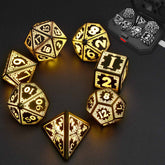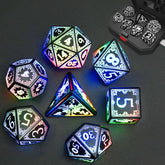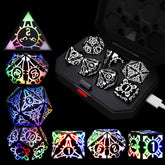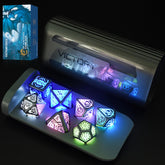How to Read Dice Rolls for Beginners
Dice Basics

The most common dice used in games are four-sided dice (d4), six-sided dice (d6), eight-sided dice (d8), ten-sided dice (d10), twelve-sided dice (d12), and twenty-sided dice (d20).
- Four-sided dice have one number on each face, ranging from 1 to 4.
- Six-sided dice have one number on each face, ranging from 1 to 6.
- Eight-sided dice have one number on each face, ranging from 1 to 8.
- Ten-sided dice have one number on each face, ranging from 1 to 10.
- Twelve-sided dice have one number on each face, ranging from 1 to 12.
- Twenty-sided dice have one number on each face, ranging from 1 to 20.
Special Dice

Percentile dice (d%) are used to simulate probabilities from 1% to 100%. They consist of two ten-sided dice, one marked with 00, 10, 20, 30, and so on, and the other marked with 0, 1, 2, 3, and so on. To read a percentile dice roll, you add the numbers together. For example, if you roll a percentile dice and get 00 and 1, the result would be 1%. Conversely, if you roll 10 and 0, the result would be 10%.
Three-sided dice (d3) have three faces, each marked with a number from 1 to 3. To read a three-sided dice roll, you simply add the numbers together. For instance, if you roll a three-sided dice and get 1, 2, and 3, the result would be 6.
Xdy Rules
In many tabletop games, dice rolls are often represented in the form of Xdy, where X represents the number of dice and y represents the number of faces on each die. For example, 2d6 means rolling two six-sided dice. To determine the result of an Xdy roll, you multiply X by y. Therefore, 2d6 would mean rolling two six-sided dice, resulting in a total ranging from 2 to 12.
Common Dice Terminology
Hit: A successful dice roll.
Miss: An unsuccessful dice roll.
Success: A dice roll that meets or exceeds a specific target.
Failure: A dice roll that does not meet or exceed a specific target.
Critical success: A dice roll that produces the highest possible result.
Critical failure: A dice roll that produces the lowest possible result.
Why are there two d10s in a dice set?
In many tabletop games, percentile dice are often replaced by two ten-sided dice (d10). This substitution allows for a wider range of numbers to simulate percentages accurately. By rolling two d10s and combining the results, you can achieve values from 1 to 100, with each number having an equal chance of occurrence.
How to read percentile dice?
Percentile dice consist of two ten-sided dice, one marked with numbers ending in 0 (10, 20, 30, etc.), and the other marked with numbers from 0 to 9. To read percentile dice, you simply add the numbers shown on both dice. For example, if you roll a percentile dice and get 00 and 1, you would add them to get a result of 1%. If you roll 10 and 0, the result would be 10%.
How to read three-sided dice?
Three-sided dice have three faces, each marked with a number from 1 to 3. To read a three-sided dice, you add the numbers shown on the faces together. For instance, if you roll a three-sided dice and get 1, 2, and 3, the result would be 6.
Dice Strategy: Is there a strategy to rolling dice?

In addition to understanding how to read dice, employing effective dice rolling techniques can enhance your gameplay. Here are some tips:
1. Use a flat, smooth surface for rolling dice.
2. Roll the dice with enough force to ensure randomness but avoid excessive force.
3. Control the dice's rotation by using your fingers or thumb.
4. Experiment with different rolling techniques to find a method that yields desired results.
However, it's important to remember that dice ultimately rely on luck. Even with these tips, there is no guarantee of achieving specific outcomes consistently.







